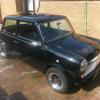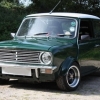
1310 Engine & Power Figures
#16

Posted 21 December 2012 - 12:30 AM
#17

Posted 21 December 2012 - 09:59 PM
#18

Posted 21 December 2012 - 10:17 PM
It will be 'orrible in traffic and the cruising speed will not be high due to the need for low gearing to keep it 'on the cam'. The 286 is my favourite cam for a rally car, but I would never use on in a road car.
#19

Posted 21 December 2012 - 10:32 PM
#20

Posted 21 December 2012 - 10:35 PM
#21

Posted 21 December 2012 - 11:05 PM
Sorry if this is 'teaching grandmother how to suck eggs', but if a race or semi-race cam is chosen it is chosen to give power. Now that power will be at certain revs, usually high, and if a car is going to be driven 'off the cam', i.e. outside its optimum revs for best power, then it's the wrong cam for the application. For a road cam what is needed is a good area under the cam performance graph at the revs you'll be using on the road. This is usually between about 2500 and 5500 rpm. But a 286 gives its grunt between about 5000 and 6700 rpm, peakin g at 6400 rpm.
An engine with that characteristic will be revving its nuts off all the time its being used. If it's not then the engine is not performing as it is meant to with that cam and it's the wrong cam for the job. In that case the engine will be giving less power than it needs at the lower revs.
The best road cam is almost certainly the 266/MG Metro (effectively identical) as they give power right up to just over 6000 rpm, but perform well from about 2500 rpm.
An engine revved to over 6500 all the time won't last long.My 'S' rally car has a 286 and I rebuild the engine very frequently and that's with an EN40B forged steel nitrided crank and Karl Schmidt pistons. The 286 is really almost a full-race cam and race engines are rebuilt very often. On a road car allow for a re-build every 8000 to 10000 miles and maybe more often than that. It's the high revs that kill it together with the necessary low ratio final drive which spoils cruising speed.
#22

Posted 21 December 2012 - 11:34 PM
#23

Posted 22 December 2012 - 01:03 PM
#24

Posted 28 December 2012 - 08:07 AM
My 'S' rally car has a 286 and I rebuild the engine very frequently and that's with an EN40B forged steel nitrided crank and Karl Schmidt pistons.
Curious, what exactly fails to require a rebuild every 10k miles?
#25

Posted 28 December 2012 - 10:05 AM
From what I can gather about the 123 and the new 'Amethyst',theres just no comparison and I think the cost is similar.The 123 would have to be considered history now.It uses pre-set advance curves and can never be right for an engine in all circumstances,just a compromise and 'near enough'. This would be for a road engine I mean.If the new Amethyst does what we all assume it does then it's infinately adjustable and can be set up absolutely perfect for a given engine--just like Megajolt which is what I use.You chaps speak of Megajolt. Would the 123Ignition distributor not be an option in this case?
#26

Posted 28 December 2012 - 10:55 AM
#27

Posted 28 December 2012 - 12:14 PM
I have one on a mgc straight six
#28

Posted 28 December 2012 - 03:24 PM
My 'S' rally car has a 286 and I rebuild the engine very frequently and that's with an EN40B forged steel nitrided crank and Karl Schmidt pistons.
Curious, what exactly fails to require a rebuild every 10k miles?
Nothing should fail, which is why race and rally engines have precautionary re-builds so often. At sustained high revs, like constant use of 6500 rpm+, the rate of wear on the main bearings and in particular the centre main cause high bearing wear, high bore wear and high oil-pump wear. So after every few races or rallies the engine is stripped, the crank checked for wear or scoring, a new top-quality oil pump is fitted together with all new main and big-end shells plus new cam followers and new timing chain. The cam lobes are inspected for any slight cracking in the case hardening, a new head gasket is fitted and the valves are lightly re-lapped in again. At the same time the trasnsmission is inspected for undue wear, chipped teeth, etc. If there is some bore wear it is usual to lightly hone and fit new rings or re-bore and fit new pistons. As a guide I strip and check after 7 or 8 rallies and re-bore after about 15 to 20 events.
When an engine gets to +0.060" and needs a re-bore it should be sleeved back to 1275 and fitted with new pistons.
It is the high revs needed to make a 286 cam and beyond work properly which cause wear so quickly.
#29

Posted 10 February 2013 - 01:01 AM
#30

Posted 10 February 2013 - 09:41 AM
0 user(s) are reading this topic
0 members, 0 guests, 0 anonymous users

















